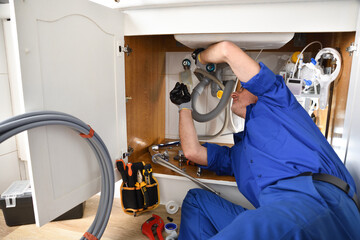If you are someone who is not familiar with plumbing, you might not know the differences between drain cleaning and sewer cleaning. But in the plumbing world, these two are very different. To understand what they are, we must first know what a drain is and what a sewer is.
A drain and a sewer, while closely related, serve different functions in wastewater management.
Recommended reading: Top 5 Benefits of Drain and Sewer Services

A drain is a pipe that carries used water and waste away from a specific plumbing fixture or appliance within a building. Examples include sink drains, shower drains, floor drains, washing machine drains, etc. Drains typically have a U-shaped pipe called a trap to prevent sewer gases from entering the living space. Drains connect to and feed into the larger sewer system.
A sewer is a system of underground pipes that collects and transports sewage and wastewater away from multiple drains and buildings. The sewer line runs under streets and properties, eventually connecting to municipal sewage treatment facilities. Sewers handle all the waste discharged from toilet fixtures as well as water from drains. Sewer systems use gravity or pumps to keep waste moving through the pipes. Sewer main lines are usually made of heavy-duty materials like concrete or clay to withstand waste flow.
Recommended reading: Drain and sewer services in Houston
Drain cleaning refers to the process of removing clogs, buildup, or obstructions from drain pipes to restore proper water flow and drainage.
There are several common methods used for drain cleaning:
For more information about professional drain cleaning services, please contact us at 713-688-2304
Sewage cleaning refers to the process of clearing out and removing blockages or buildup from sewer pipes and sewer lines. It is more extensive than just drain cleaning within a building.
Here are some of the main methods involved in sewage cleaning:
Recommended reading: Drain cleaning: What is it and how is it done?
Drain cleaning and sewer cleaning, while related, target different parts of a building’s wastewater disposal system and serve distinct purposes. Here are the key differences between the two:
Drain Cleaning: This focuses on the removal of clogs and blockages in the individual drain lines within a building. These lines are directly connected to fixtures like sinks, toilets, bathtubs, and showers. Drain cleaning is typically concerned with the pipes and drains inside the building or immediately outside it.
Sewer Cleaning: Sewer cleaning deals with the larger sewer line that connects a building’s plumbing system to the municipal sewer system or a septic tank. This cleaning is more comprehensive and addresses blockages or issues that affect the entire building’s wastewater flow, not just individual fixtures.
Drain Cleaning: Common tools and techniques include plungers, drain snakes/augers, and chemical or enzymatic cleaners. The focus is on addressing localized clogs and maintaining clear pathways for water and waste within individual lines.
Sewer Cleaning: Techniques like hydro-jetting and sewer snaking are more common here, designed to handle larger pipes and more substantial blockages. Sewer cleaning may also involve more advanced diagnostic tools, like video inspection, to identify issues deep within the sewer line.
Drain Cleaning: Generally simpler and often a DIY task, drain cleaning tackles smaller-scale issues. It’s usually the first response to slow drains or minor blockages.
Sewer Cleaning: This is a more complex and large-scale operation, often requiring professional intervention. It addresses the system-wide flow of wastewater and is crucial for preventing backups that can affect multiple fixtures or entire buildings.
Drain Cleaning: is often performed as needed, when there’s a noticeable problem with a specific drain. It can also be part of regular maintenance to prevent clogs.
Sewer Cleaning: Typically part of a more extensive maintenance routine, sewer cleaning is less frequent but crucial for the long-term health of the plumbing system. It helps prevent severe blockages and backups that can lead to significant property damage and health hazards.
Whatever you’re experiencing, we have the technical expertise to help. Click below to share your information along with any specific details or photos, and we’ll be in touch with you as soon as possible with an estimate.